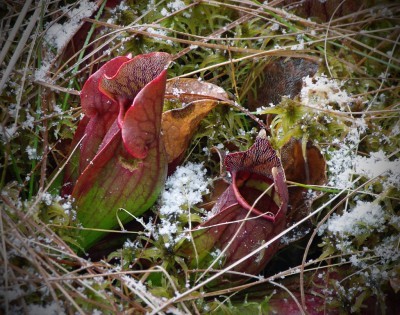






Sarracenia, or pitcher plants, are native to North America. They are classic carnivorous plants that use trapped insects as part of their nutrient needs. These specimens need moist conditions and are often found near water. Most varieties are not extremely cold hardy, which makes pitcher plant care over winter very important.
During pitcher plant dormancy, some exposure to chilly temperatures is necessary but most are not hardy below USDA zone 7. Over wintering pitcher plants in colder zones will require moving the plants or providing them with protection from the cold weather.
Pitcher plants are bog plants and are often grown as part of a water garden or at the edge of a water feature. The genus Sarracenia supports 15 different varieties scattered across North America. Most are common in zone 6 and readily survive their areas cold snaps.
Plants that grow in zone 7, such as S. rosea, S. minor and S. psittacina, need a little help when freezes occur but can usually stay outside in cold temperatures. The most cold hardy species, Sarracenia purpura, can survive zone 5 outside.
Can pitcher plant survive indoors during the winter? Any variety of pitcher plant is suitable for growing in a greenhouse with controlled conditions. Smaller varieties may be brought into the home for winter if you provide air circulation, humidity and a warm situation.
Plants in USDA zone 6 are acclimated to short freezing periods. Pitcher plant dormancy requires the chilling period and then warm temperatures that signal it to break dormancy. The chilling requirement is important for all species of Sarracenia to signal when it is time to begin growing again.
In extreme cold, apply a thick layer of mulch around the base of the plants to protect the roots. If you have varieties growing in water, break the ice and keep the water trays full. Caring for pitcher plants in winter in colder zones will require you to bring them indoors.
Potted species of S. purpurea can stay outdoors in a sheltered location. All other varieties should be brought in to a cool covered location, such as a garage or unheated basement.
Reduce water and do not fertilize when providing pitcher plant care over winter for the less hardy species.
This is a great question. As with any plant, the key to overwintering pitcher plants is to mimic their natural habitat. This means each species will need different average temperatures, longer or shorter dormancy periods and slightly different site and growing conditions. Overall, it is safe to say that pitcher plants need warm growing conditions, plenty of moisture, peat or acidic soil, medium light levels and at least 30 percent humidity.
All these conditions can be difficult to provide in the home environment. However, since the plants are dormant for three to four months, their growing needs have slowed down. Bring potted plants to a low light area where temperatures are below 60 F. (16 C.), reduce the amount of water they have and wait for three months, then gradually reintroduce the plant to higher light and heat conditions.
Copyright © www.100flowers.win Botanic Garden All Rights Reserved